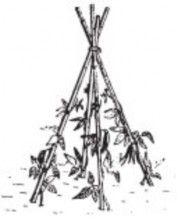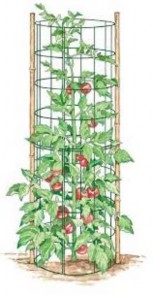Vertical Gardening Using Trellises, Stakes, and Cages
ID
HORT-189NP (SPES-450NP)
What is Vertical Gardening?
Vertical gardening is the practice of “gardening up,” in which a variety of structures are used to elevate plant growth to take advantage of vertical space. Vertical gardening is well-suited to urban areas where space is limited and gardeners are interested in using space most efficiently. Balconies, decks, patios, windowsills, fence lines, and backyard gardens are excellent places to practice vertical gardening. This publication will describe the use of vertical gardening techniques to get the most out of growing vegetables and other plants in these small spaces.
Plants that produce long sprawling vines perform well when trained to vertical support structures. Pole beans, peas, cucumbers, melons, and tomatoes are excellent candidates. Trellises, stakes, and cages allow for climbing plants that would normally take over a garden to be grown and contained in a smaller area, allowing for more space to be used for other crops. It doesn’t have to be expensive; various repurposed materials can be used to build these simple structures (Figure 1). Vertical gardening provides many other benefits beyond maximizing the use of available space. Vertically-trained plants can be easier to harvest from and bear cleaner, higher- quality fruit. Additionally, training plants upright can facilitate better air movement through the foliage, which reduces disease pressure.

Vertical Gardening Methods
Trellising
A trellis consists of a series of sturdy vertical supports that hold a lattice of some sort for plants to climb up (Figure 2). This system can be as simple as using two steel t-posts as supports, connected horizontally at the top and bottom by heavy gauge wire or wooden 2 by 4’s. Other materials include bamboo, cedar poles, and rebar, provided they are strong enough to support the weight of the plant plus fruit. Whatever material is used, be certain to drive the post at least 18 to 24 inches into the ground using a mallet or post driver. Gardeners will hang a variety of climbing surfaces from the trellis frame, including plastic netting, wood lattice, nylon fencing, or woven wire cattle fencing. The general rule of thumb is to use fencing with holes that do not exceed four inches across. This ensures that plants will be able to climb easily. When plants are small, they may need to be gently guided or tied to the trellis to encourage them to climb.

Staking
Stakes can be made out of wood, bamboo, PVC, metal conduit, or rebar, and cut to the desired length with simple home tools. Wooden stakes should be at least one inch thick to ensure sufficient strength to hold growing plants. One inch thick, five feet long “tobacco” or “tomato” stakes can be purchased at most hardware stores, and from specialty garden supply catalogs. Tomatoes and peppers can be tied singly to individual stakes.
For longer rows of tomatoes and peppers, consider using the stake and weave method (Figure 3). To begin, drive a stake between every other plant when the plants are still small. When the plants are 12 inches tall, weave the first line of garden twine between the stakes 10 inches off the ground, wrapping the twine once around each stake. The plants are held upright between the two lines of twine woven on either side of the stakes. Weave subsequent lines of string every 10 inches up the stake as the plants continue to grow. Six-foot stakes driven two feet deep are sufficiently tall for determinate tomato types. Eight-foot tall stakes are better for indeterminate types. For climbing crops like pole beans, stakes can be arranged in a tripod configuration to provide a visually interesting structure in the garden (Figure 4).


Caging
Caging is used for heavier crops, including melons and summer/winter squashes that may overburden a trellis or stake due to weight of produce. Caging is also a common approach for supporting the long vines of indeterminate tomatoes. Cages can be easily fashioned by rolling a rectangular section of metal livestock fencing or chicken wire into a cylindrical from, though any shape will do (Figure 5). Four-inch mesh spacing is wide enough to reach through for hand harvesting. If your material is smaller than that, cut larger access holes intermittently around the cage. Fasten the cage to one or two stakes driven into the ground for added stability. The size of cages varies depending on plant spacing and type of crop. Melons and squash hanging from plants growing in cages may need extra support. Slings can be made from reused materials like old t-shirts and mesh bags and attached to cages to cradle heavy fruit.

Companion Planting
While companion planting may not be considered a type of vertical gardening, it is a technique that can help save space in a small garden. Pole beans may be planted beneath sweet corn to use the corn as a living trellis. Quick-growing crops like radishes, turnips, and lettuce planted beneath vertically trained crops can be harvested before the taller crop gets too big. Lettuce may benefit from the cooler temperatures created by the shade of the taller companion. Small-statured, sun- loving crops like bush beans, eggplant, or peppers should be planted on the south side of taller crops to receive full sunlight.
Summary
Vertical gardening is a method for using space efficiently in a small garden and enables gardeners to grow a more diverse and colorful range of crops. Trellises, stakes, and cages not only provide more space for a higher yield, but they also give support to plants that are normally overloaded with produce. These methods may minimize pest problems by keeping plant foliage off the ground and increasing airflow. Trellising and companion planting can even create shade for plants that flourish in partial sunlight. Practicing vertical gardening at your home can increase the productivity, quality, beauty, and joy of your gardening experience.
Image Credits:
Figure 1. Basswulf (2006). Vertical Gardening. Retrieved April 8, 2015 from
https://www.flickr.com/photos/wulf/30385636/
Figure 2. Wikipedia. (2005). Trellis (Architecture). Retrieved April 8, 2015 from
http://en.wikipedia.org/wiki/Trellis_(architecture)
Figure 3. Bessin, R. (2014). Vegetable Production Guide for Commercial Growers. University of Kentucky Cooperative Extension Services. Retrieved March 3, 2015 from http://www2.ca.uky.edu/agc/pubs/id/id36/id36.pdf
Figure 4. Niemiera, A. (2009). Intensive Gardening Methods. Virginia Tech Cooperative Extension Services. Retrieved August 4, 2014 from
<http://pubs.ext.vt.edu/426/426-335/426-335.html>
Figure 5. Find the Right Tomato Plant Supports. Retrieved April 7, 2015 from
http://www.veggiegardener.com/choosing-the-right-supports-for-your-tomatoes/
Virginia Cooperative Extension materials are available for public use, reprint, or citation without further permission, provided the use includes credit to the author and to Virginia Cooperative Extension, Virginia Tech, and Virginia State University.
Virginia Cooperative Extension is a partnership of Virginia Tech, Virginia State University, the U.S. Department of Agriculture (USDA), and local governments, and is an equal opportunity employer. For the full non-discrimination statement, please visit ext.vt.edu/accessibility.
Publication Date
December 12, 2022



